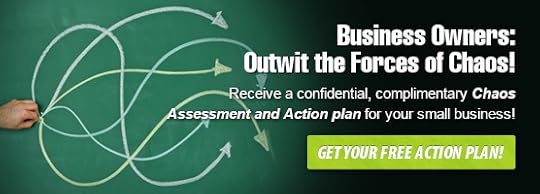Dave Crenshaw's Blog, page 50
February 20, 2013
My Priority This Week: Darci
This week’s post is about priorities. On Tuesday, my wife gave birth to our third child, Darci. She was born at 7 lbs 4 oz, has a head full of hair, and we are all absolutely in love with her.
So, instead of sending out a video this week, my priority has been to be there for my wife, my new little girl, and being Mr. Mom to my two older children.
Have a great week and make sure to respect your line in the sand! Work is great, but family is forever.
All the best,
Dave
The post My Priority This Week: Darci appeared first on Dave Crenshaw | Helping Entrepreneurs Outwit Chaos.
February 13, 2013
Confront Fear to Improve Productivity
My wife is afraid of spiders. I’m terrified of slugs and snails.
The mere sight of a slug or a snail sends my brain into fits. I bet the same thing happens to you at work sometimes with things as simple as new tasks in your inbox.
Sound bizarre? Watch this short video to learn how to improve productivity when fear strikes at the office.
Action Steps:
Whenever you feel fear, confront that fear. Stay and fight. You will find that your fear was unwarranted, and the task you were afraid of was easier to complete than you originally thought.
Use the comments section below to share your everyday fears and methods for confronting them. Let’s talk about it
Principles to Learn:
Fear triggers our “fight or flight” response. When you’re at the office and fear strikes, it’s important that you stay and FIGHT instead of retreating to distractions like Facebook or your favorite blogs.
Once you decide to confront your fear and stay on task, you’ll find that completing the task wasn’t as bad as you thought it was going to be.
The post Confront Fear to Improve Productivity appeared first on Dave Crenshaw | Helping Entrepreneurs Outwit Chaos.
February 6, 2013
Start Telling Your Company Story Like a Superhero
If you were mentoring someone, what do you think would be their first question for you? My guess: “How did you get started?”
If you were a superhero, your “first appearance” in a comic book would tell your audience how you got started. In the comic book world, this is called your “origin story.”
Like the origin story, your company story is a very exciting thing! Once you perfect it and start telling it, it will help inspire your prospects to do business with you.
Watch this short video to find out how to start telling your story.
Action Steps:
Watch the video to learn about four different origin stories common to superheroes and entrepreneurs alike.
Use the comments section to tell me how you got started. I look forward to hearing your story.
Principles:
Destiny. Like Superman, you were born with the gifts required to succeed.
Decision. You saw an opportunity, and you decided to go out and do it. Like Batman, you had to learn and acquire the necessary skills to be successful.
Adversity. Life put you into a position where you have to create something in order to survive. The superhero equivalent is Ironman, who had to create the suit to escape from captivity.
Accident. Sometimes you stumble into entrepreneurship through happy accident, similar to the origins of Spiderman.
The post Start Telling Your Company Story Like a Superhero appeared first on Dave Crenshaw | Helping Entrepreneurs Outwit Chaos.
January 23, 2013
Why You Shouldn’t Stop Procrastinating
Procrastinate as much as possible. Seriously. You’re going to do it anyway, so you might as well do it right.
You don’t have to stop procrastinating as long as you’re doing it properly. Find out how in this short video.
Action Steps:
In order to make procrastination your friend, you need to do three things:
Whenever you commit to something, you always put it in your calendar.
Keep a simple system for processing your items, like the one I teach in my book, Invaluable.
Keep a “perhaps” list to stay focused. Instead of putting good, low-priority items on your calendar, put them on the perhaps list instead.
What would you suggest about procrastinating appropriately? Please leave a comment on this page, and let’s talk.
Principles to Learn:
In my system, there’s no prioritization of tasks. Priority is a function of time.
Your calendar is your ultimate prioritization tool. It’s your master list.
Your “Perhaps” list is for good, but distracting, ideas that you’re not ready to commit to yet.
The post Why You Shouldn’t Stop Procrastinating appeared first on Dave Crenshaw | Helping Entrepreneurs Outwit Chaos.
January 16, 2013
Grow Business Profit Before You Chase Sales
Pick up a copy of Inc. or Fast Company, and you will be amazed by how many entrepreneurs are bent on selling themselves straight into bankruptcy.
It costs a lot of money to grow sales, especially if you’re focused on the wrong things, like making Inc.’s list of the 5000 fastest growing businesses in the country. What is more important than sales to your business? Watch this short video to find out.
Action Steps:
List all of your lines. List every category of product or service your business sells.
Determine the profit per unit, or, if you’re selling a service, the profit per hour sold. Subtract your cost per unit sold from the price of each unit. The line with the most business profit is your Most Valuable Line (MVL).
To avoid using your MVL to subsidize your Less Valuable Lines (LVL), eliminate your LVLs. Stop selling them. Drop them from your business and focus on selling your Most Valuable Line.
Repeat the process on a regular basis–at least once, if not twice, a year.
Principles:
A lot of businesses sell themselves into bankruptcy by not paying attention to business profit–specifically net profit per unit sold. Instead, they focus on growing sales and take their eye off of expenses completely.
This happens when business owners fail to keep a close eye on the costs involved in selling a unit of product or an hour of service.
Over diversified businesses often wind up robbing Peter to pay Paul, meaning that the profitable lines of their business end up subsidizing the unprofitable lines.
Net profit is a far, far more important measure of success than sales growth.
The post Grow Business Profit Before You Chase Sales appeared first on Dave Crenshaw | Helping Entrepreneurs Outwit Chaos.
January 9, 2013
Why You Should Never Use a Pencil When Scheduling Appointments
There’s a certain phrase that I train my assistant to never use when scheduling appointments. If fact, she knows that if someone uses this phrase when trying to schedule an appointment with me, she should refuse the appointment.
What is the phrase and why should you avoid it, too?
Watch this brief video to find out.
Action Steps:
Before you schedule another appointment, whether it’s with yourself or someone else, make sure you are truly committed before putting it in your calendar.
Avoid allowing others to try to “pencil you in.” It means they aren’t committed to meeting with you. Try to find a time you both can commit to.
Share other comparisons in the comments section below. What differences can you see between merely “scheduling” an appointment vs. “committing” to it?
Principles to Learn:
Scheduled appointments are fragile and easily broken. Appointment commitments are firm and protected.
People who simply schedule meetings without committing to them are likely to show up but not participate.
If you lack commitment to a scheduled appointment, you’ll be easily distracted.
When you schedule time without committing to it, you devalue yourself. On the other hand, when you commit to a scheduled appointment, you increase your personal value and the value of those around you.
January 2, 2013
What’s Your Business Goal?
How was 2012 for you? Good, bad, ugly? Fantastic?
2013 is already upon you and your business. What are you doing about it?
The truth is there’s really only ONE business goal you need to focus on to make this the best year ever. In this short video, I’ll help you discover that one goal. Please watch and share.
Action Steps:
Make a list of possible answers to this question: “If we were to accomplish just one business goal in 2013, what would make the biggest impact?”
Pick just one goal from that list to focus on in the coming year.
In a written or recorded format, document that goal and share it with your employees or support team.
On your calendar, mark down the dates of when major milestones toward that one business goal need to be completed.
In the comment section below, share your one big goal for the coming year.
Also support my friend, Les Hewitt, by buying his book, The Power of Focus : http://amzn.to/W9vLS9
Principles:
By making just one major improvement at a time, you’ll find success comes to your business more consistently.
Written, documented goals are more powerful and actionable than stated or imagined goals.
When your employees can see a written business goal, it makes it easier for them to focus their intention and support the business.
December 26, 2012
The Myth of Multitasking – Uncut Presentation
In between the family, friends, gifts and overeating, I wanted to give you something special.
Ever seen me on stage? Here’s your chance: Watch my uncut presentation on The Myth of Multitasking from EO Alchemy in Seattle.
This TED-style speech is under 17 minutes and is my gift to you. Enjoy!
Action Steps:
Interested in having Dave speak to your group in the coming year? Visit DaveCrenshaw.com/speaker. Act fast! Dave’s schedule fills quickly.
Principles to Learn:
There are four primary effects of The Myth of Multitasking:
The time it takes to complete things INCREASES.
The quality of your work DECREASES.
Your stress levels—and the stress levels of those around you—INCREASES.
The quality of your relationships DECREASES.
The post The Myth of Multitasking – Uncut Presentation appeared first on Dave Crenshaw | Helping Entrepreneurs Outwit Chaos.
December 19, 2012
How Clear Is The Exit Strategy For Your Business?
A business owner recently asked me: “How do I begin planning to exit my business?” It’s a great question—but it may be premature for most business owners.
In this brief video, I’ll walk you through the four questions every entrepreneur should ask themselves first, before they begin planning an exit strategy.
Action Steps:
Ask yourself these four critical questions in relation to your business exit strategy:
What do you want? – The more clearly you can define the exit, the better.
Why do you want it? – Your motive for exit will have a strong bearing on your success.
When do you want it? – Your answer will guide how much time, money, and risk will be required.
What is the next step? – No matter where you are, right now, you can begin the process of preparing for business exit.
If you haven’t yet seen it, watch my video about mini-business harvest strategy: http://davecrenshaw.com/mini-business...
Please share your perspective on exit strategy or ask questions on this page.
Principles:
Most business owners lack clarity about what they really want from their business.
If you are exhausted and worn out with being a business owner, you may just need to leave the business, not seek a harvest.
The faster the desired exit from your business, the more personal work time, investment capital, and risk will be required.
The post How Clear Is The Exit Strategy For Your Business? appeared first on Dave Crenshaw | Helping Entrepreneurs Outwit Chaos.
December 12, 2012
How To Identify a Good Employee
Your employees aren’t quite up to snuff, but how do you know whether to keep training them or fire and re-hire? Are they truly good employees?
This short video will show you how to make the cut. Please watch and comment.
Action Steps:
Start by making a list of your “Top 3” employees. If you can’t think of any who currently work for you, think of people from the past whom you really loved.
Then, list the three traits that made these people good employees.
Next, look for traits these employees have in common.
Compare those three shared traits to every single employee you have working for you right now.
If an employee matches those traits, keep working with them. If they don’t fit those traits, they’re an “LVE,” a Less Valuable Employee. You may want to look at replacing them with someone who fits the company better.
Principles to Learn:
The “MVE,” or Most Valuable Employee, is the person who brings the most to your business and your bottom line, regardless of what position they occupy.
No matter what position they’re in, MVEs are good employees who can bring the most to the bottom line because they fit the business.
Traits are more important than skills. While you can develop skills, it’s difficult or impossible to develop traits in other people, including employees.
The post How To Identify a Good Employee appeared first on Dave Crenshaw | Helping Entrepreneurs Outwit Chaos.
Dave Crenshaw's Blog
- Dave Crenshaw's profile
- 43 followers









